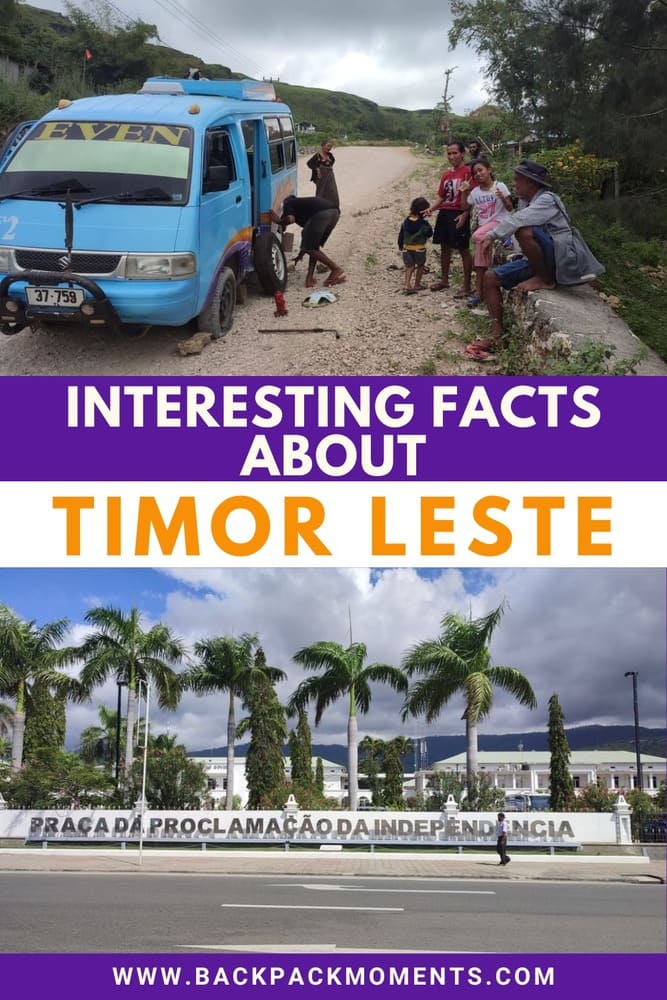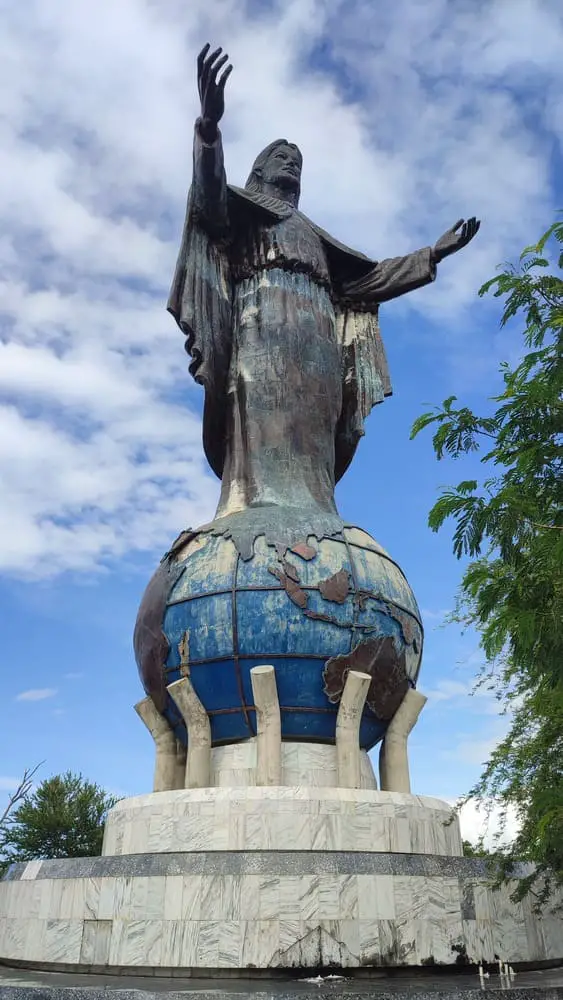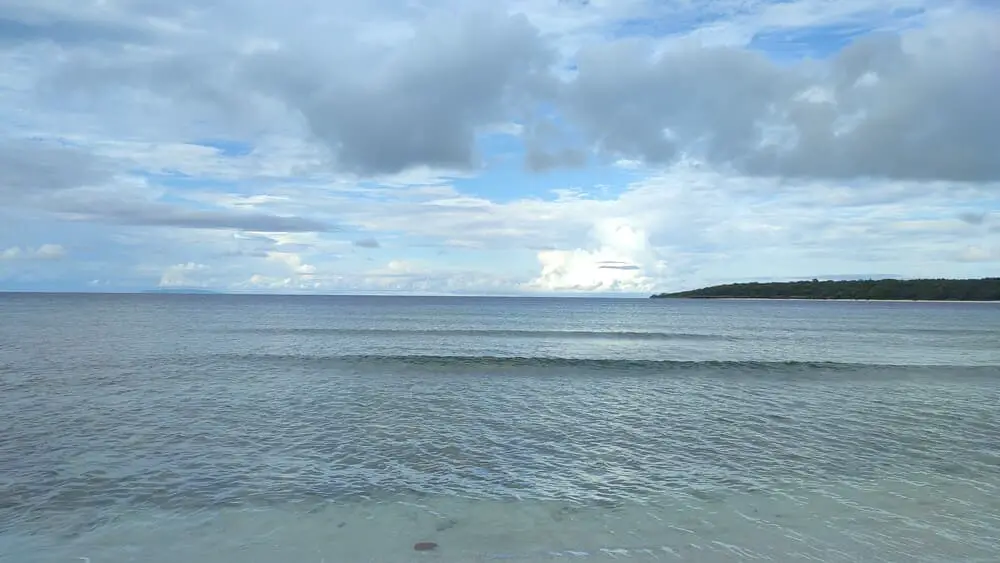23 Interesting Facts about Timor Leste (From my trip there!)
This post may contain affiliate links. If you make a purchase using one of these links, I may receive a small reward at no extra cost to you. See my Disclosure Policy for more information.
Timor Leste, or East Timor, is a little-known country that few people travel to. Its remote location on half of the island of Timor, situated between Southeast Asia and Melanesia, means that it’s both difficult and costly to visit.
But that it’s also a diverse and complex region with a storied history and eclectic traditions. Here are 23 fun facts about Timor Leste!
Click here to read my complete guide to backpacking in Timor Leste!
1. It’s the fourth youngest country in the world
Timor Leste officially gained independence on May 20, 2002, making it Asia’s newest country to date! in the years since it has fallen down to the number 4 spot, as Montenegro, Kosovo, and South Sudan gained independence in 2006, 2008, and 2011 respectively.
2. Timor Leste was a Portuguese colony
Portuguese presence on the island began in the early 16th century and Timor Leste officially became a Portuguese colony in 1702 (the rest of the island and the other Indonesian islands were under the Dutch).
The Japanese entered the fray for 3 years between 1942 and 1945. It was bloody. At least 60.000 Timorese lost their lives.
The Portuguese left quite suddenly in 1975 allowing East Timor a few months of self-determination (and a short civil war) before the Indonesians came in December 1975 and occupied it again.
The Indonesian military left in 1999 and Timor Leste was administered by the UN until 2002 when it finally became independent.

3. Timor Leste’s name is a tautology
Timor (or Timur) means “east” in Indonesian and Leste also means “east” in Portuguese. This makes the country’s name East East if translated verbatim and is the reason why some English-speaking countries call it East Timor.
The name of the country in the local Tetun language is Timór Lorosa’e, which translates to “Where the sun rises“. So where does the sun rise after all – Japan or Timor Leste?
4. The official languages are Tetun and Portuguese
It was a contentious decision by the government to pronounce Portuguese, a language that only 5% of the people speak, and of a colonial power long gone, as the official in Timor Leste. It is though, together with Tetun, the local lingua franca that practically everybody knows.
Other significant languages are Indonesian, spoken by around 40%, and English, spoken mostly by younger people. Check out these Indonesian phrases that will surely also help you in Timor Leste too.
There are more than 32 local indigenous languages in Timor Leste and practically everybody is a polyglot – I came across many people who spoke 4,5,6 or even more languages!
5. Timor Leste is very Christian. But with a twist.
Timor Leste is one of only two predominantly Christian nations in Southeast Asia, the other being the Philippines, and one of only 6 in all of Asia (the rest being Georgia, Armenia, Russia, and Cyprus. Yes, these are geographically Asian countries.
While on paper Timor Leste is 96% Christian Catholic, the reality is a little more complicated. It’s all because of the colonial history.
When the Portuguese came with its Franciscan monks and tried to spread Christianity, they succeeded in a very limited way. Then they stopped trying and instead focused on exploiting the land for its natural resources. Few Timorese were Christians back then, most followed their own animistic religions.
When the Indonesians came in 1975, at a high point in the Cold War, they instituted their Pankasila Doctrine which allows and recognizes only 5 religions: Islam, Protestantism, Catholicism, Buddhism, and Hinduism.
Not having a religion was (still is in Indonesia) not possible and anyone who declared they were following an animistic religion or to be non-religious / an atheist was immediately considered a communist. Communists were really not looked after well.
Most Timorese declared themselves Catholic to save their lives.
To this day, even though most follow the Catholic faith, animism is alive and well. Christianity in Timor Leste is thus weird – yes, Jesus is the Lord and Saviour, but there are also ancestral spirits all around us helping and guiding us in our endeavors. At least that’s what many Timorese believe.
6. Timor has been inhabited for at least 42.000 years!
There is evidence coming from prehistoric caves in the east of Timor Leste (get it, East East East, hehe) that our ancestors settled on the island a looong time ago.
Yes, 42.000 might not sound like a lot of time in the grand scheme of things, but when it comes to humans, it’s basically a quarter of the years we’ve been around as a separate species! That’s impressive!
You can visit the caves Jerimalai and Lene Hara, but take a machete with you to clear the vegetation around. They are just before Valu Beach and Jaco Island.
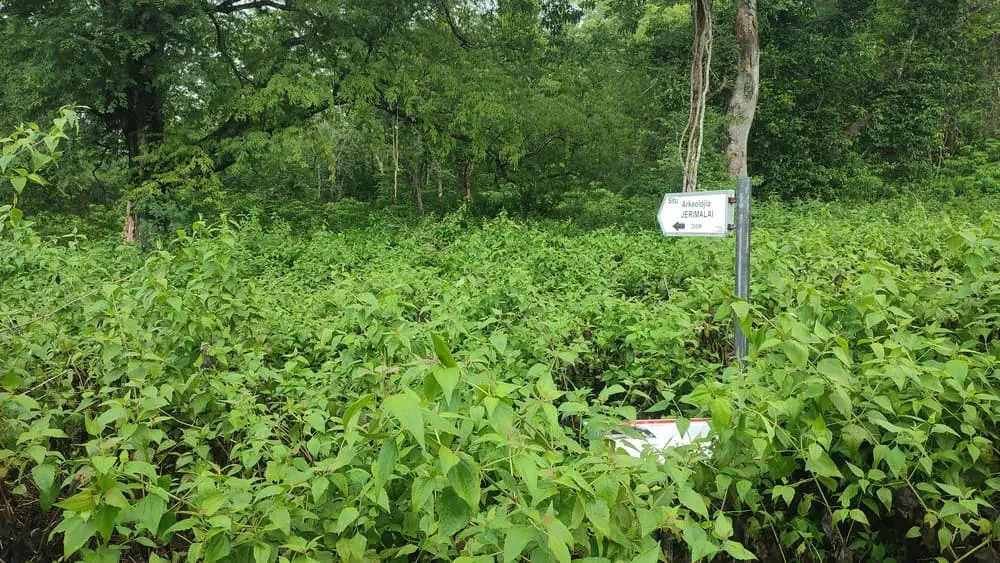
7. Timor Leste has no UNESCO heritage sites
Timor Leste joins 26 other countries with 0 UNESCO heritage sites on their territory. That’s a pity though – the country is beautiful and has several virgin rainforests, pristine beaches, and marvelous mountains.
However, the traditional Tais is inscribed on the list of intangible cultural heritage. Tais is the handwoven traditional textile of the Timorese people that plays an important role in rituals and traditions.
8. East Timor is extremely biodiverse
Let’s begin with the fact that Timor lies on the east side of the Wallace Line – an imaginary line between Bali and Lombok that marks the change in animals one encounters.
Whereas west of the line the fauna is more Asian – monkeys, big cats, elephants, east of it it’s more Australian – marsupials and weird creatures like the platypus.
Timor lies in what’s called Wallacea – the zone east of the Wallace line, but west of Australia. As such it has examples of both faunas – Asian mammals, but also Australian crocodiles.
When it comes to birds and fish, Timor Leste boasts an unprecedented biodiversity. The island of Atauro was recently found to have the most biodiverse waters in the world per square kilometer.
9. Timor Leste has only 1 National Park
Given the biodiversity and the amount of untouched land, you’d think that there’d be more than just one National Park. Alas, it’s just the Nino Konis Santana National Park in the east of the island. It includes the mythical Jaco Island.
10. Two Timoreans share the Nobel Peace Prize of 1996
They are Carlos Filipe Ximenez Belo, a catholic priest and the administrator of the Diocese of Dili at the time, and José Ramos-Horta, a political activist and a Fretilin Resistance leader (also the current president of Timor Leste since 2022).
They received the award for their continuing work towards a just and peaceful solution to the conflict in East Timor.
11. Timor Leste produces amazing coffee
Given its small size, it’s a surprisingly big producer of coffee. The coffee in East Timor is all bio. You can be sure of that because the locals simply don’t have the money to buy fertilizers and pesticides.
The biggest buyer is none other than Starbucks!
12. Timor is not a volcanic island
Unlike the nearby islands of the Sunda chain (like Java, Bali, Nusa Tenggara, etc), Timor is not volcanic in origin. It was created in the smashing of the Australian plate into the Sunda plate.
Thus, it’s a safe island when it comes to volcanic eruptions and earthquakes. The drawback is that the land is not as fertile as, say, Java where 150 million people live due to the extremely fertile volcanically-enriched soil.
13. The locals greet you in Portuguese and are very punctual
Owing to the Portuguese history and influence, the locals have adopted many Portuguese sayings in their everyday life. One thing you’ll hear a lot in Timor Leste is greetings! Everyone will greet you, be it a playful 5-year-old or a charming 85-year-old lady.
The greetings are in Portuguese: Bon Dia for Good Day, Bon Tarde for Good Afternoon.
I noticed they are very particular about the timing of Bon Tarde. The moment the clock hits 12:00, the greeting switches.
Once a woman greeted me with Bon Dia, looked at her watch, and corrected herself to Bon Tarde. It was 12:03.
14. Half the population is kids
Timor Leste is one of the youngest countries in the world. No, I don’t mean the country’s age, as explored in the first fact above. I mean the age of their people.
According to recent statistics, half the population is under the age of 20. This is palpable! You’ll see kids everywhere around you!

15. Almost every house has one of two flags – Fretilin or CNRT
Politics in Timor Leste is a contentious issue. There has always been a clash of ideas as to what is best for the country.
While in the past those clashes frequently became physical, in recent years East Timor has been peaceful and stable. Nonetheless, political rivalry persists. But isn’t that what democracy is all about?
The two biggest parties are Fretilin and CNRT.
Fretilin is the direct descendant of the guerilla organization that fought to resist the Indonesian occupation between 1975 and 1999.
CNRT is the party of the former rebel and legendary resistance leader Xanana Gusmão.
Almost every house in Timor Leste has the flag of one of those political parties flying high. It’s not rare to go to a small village with a handful of houses and have 3 bear the flag of Fretilin and another 3 of CNRT.
16. Transport in Timor Leste is difficult
Albeit the small size (only 15.000 square km.), Timor Leste’s mountainous terrain and lack of infrastructure make traveling inside the country a challenge.
Recently a new road was built on the north coast connecting the border town Batugade with Lautem, passing through Dili and Baucau.
But go off this road and the conditions quickly become similar to those at the Moon craters.
Construction works continue all across the country and soon Timor Leste might have new, awesome roads. Until then, just keep in mind that the standard speed south of the newly built main road is 15 km/hour.
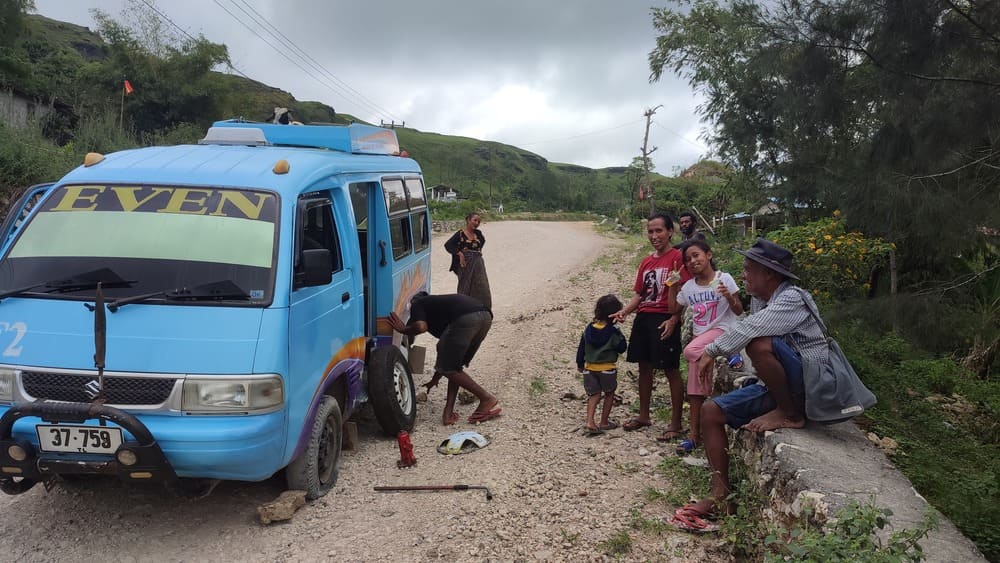
17. Timor Leste experienced a once-in-a-lifetime Total Solar Eclipse in 2023
Total Solar Eclipses are incredibly rare with 1 happening somewhere on Earth only every 18 months. The average human on Earth never sees an eclipse during their life.
Timoreans living in 2023 got lucky. They witnessed the incredible Total Solar Eclipse phenomenon on 23 April 2023. I was traveling there at this time, so I documented my experiences in this story.
18. Timor Leste was a refueling stop for long-haul flights
It was, but not anymore. Back in the day, Baucau Airport was one of the biggest airports in the region (actually the biggest between Australia and Java) and was used as a stop for big airplanes to refuel as they traveled from Australia to Indochina, Japan, or Europe.
Today Baucau Airport is only used for short domestic flights, but there are plans to once again make it a local hub.
20. Its tallest peak stands at 2986 m.a.s.l.
That was really surprising to me when I found out! The tallest peak – Mt. Ramelau (or Tatamailau), located 70 km south of the capital Dili, is higher than the tallest peak in my home country – Bulgaria (Musala, 2925).
Timor is a pretty mountainous island and there are other tall notable peaks like Mt. Matebian.
Regardless of the height, Mt. Ramelau is easy to climb in 2-3 hours from the village of Hato Buillico offering amazing views of the whole island.
21. The currency is the US dollar, but no cents!
Is that a fun fact? I don’t know – we have to define fun. Is it surprising? I’d say yes, but anyone who knows more about how difficult it is to conduct your own fiscal policy as a nascent country would probably say no.
Either way, you’ll be looking at American presidents when you look at your wallet during your stay in East Timor.
That’s when it comes to the banknotes. The coins are the East Timor centavos!
They are unique and quirky little coins that are on par with the US cents and come in much the same denominations – 1, 5, 10, 25, and 50 centavos, but also 100 and 200 centavos.
That’s to cut down on the cost of buying and replacing low-value banknotes like the 1 and 2 dollars.
Click here to learn more about the practicalities of money in Timor Leste as a tourist.
22. The crocodile is a sacred animal. But also deadly.
There is a legend about how the island of Timor formed. A crocodile was sick and a boy cured him. The crocodile gifted his body as an island and the boy is considered to be the first Timorean. People of East Timor still believe they are descended from this one boy (who’s the first woman, Timor, who?)
Crocodiles are considered sacred in Timor Leste. Unfortunately, many underestimate the danger they pose and on average there is one crocodile attack per month in the country. Half of these don’t end happily.
23. Old, traditional buildings still stand
I was pleasantly surprised to see traditional houses in Timor still standing. They are called Uma Lulik and play a vital role in local lore and traditions.
In the east you can still see some Fakaluku houses, standing on stilts as if supported by magic.
